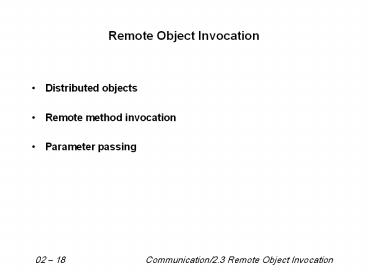Remote Object Invocation - PowerPoint PPT Presentation
Title:
Remote Object Invocation
Description:
02 19 Communication/2.3 Remote Object Invocation ... Server skeleton handles (un)marshaling and object invocation. Remote Distributed Objects (2/2) ... – PowerPoint PPT presentation
Number of Views:15
Avg rating:3.0/5.0
Title: Remote Object Invocation
1
Remote Object Invocation
- Distributed objects
- Remote method invocation
- Parameter passing
02 18 Communication/2.3 Remote Object
Invocation
2
Remote Distributed Objects (1/2)
- Data and operations encapsulated in an object
- Operations are implemented as methods, and are
accessible through interfaces - Object offers only its interface to clients
- Object server is responsible for a collection of
objects - Client stub (proxy) implements the interface
- Server skeleton handles (un)marshaling and object
invocation
02 19 Communication/2.3 Remote Object
Invocation
3
Remote Distributed Objects (2/2)
Compile-time objects Language-level objects,
from which proxy and skeletons are automatically
generated. Runtime objects Can be implemented
in any language, but require use of an object
adapter that makes the implementation appear as
an object. Transient objects live only by
virtue of a server if the server exits, so will
the object. Persistent objects live
independently from a server if a server exits,
the objects state and code remain (passively) on
disk.
02 20 Communication/2.3 Remote Object
Invocation
4
Client-to-Object Binding (1/2)
- Object reference Having an object reference
allows a client to bind to an object - Reference denotes server, object, and
communication protocol - Client loads associated stub code
- Stub is instantiated and initialized for specific
object - Two ways of binding
- Implicit Invoke methods directly on the
referenced object - Explicit Client must first explicitly bind to
object before invoking it
02 21 Communication/2.3 Remote Object
Invocation
5
Client-to-Object Binding (2/2)
- Some remarks
- Reference may contain a URL pointing to an
implementation file - (Server, object) pair is enough to locate target
object - We need only a standard protocol for loading and
instantiating code - Observation Remote-object references allow us to
pass references as parameters. This was difficult
with ordinary RPCs.
02 22 Communication/2.3 Remote Object
Invocation
6
Remote Method Invocation
- Basics (Assume client stub and server skeleton
are in place) - Client invokes method at stub
- Stub marshals request and sends it to server
- Server ensures referenced object is active
- Create separate process to hold object
- Load the object into server process
- Request is unmarshaled by objects skeleton, and
referenced method is invoked - If request contained an object reference,
invocation is applied recursively (i.e., server
acts as client) - Result is marshaled and passed back to client
- Client stub unmarshals reply and passes result to
client application
02 23 Communication/2.3 Remote Object
Invocation
7
RMI Parameter Passing (1/2)
- Object reference Much easier than in the case of
RPC - Server can simply bind to referenced object, and
invoke methods - Unbind when referenced object is no longer needed
- Object-by-value A client may also pass a
complete object as parameter value - An object has to be marshaled
- Marshall its state
- Marshall its methods, or give a reference to
where an implementation can be found - Server unmarshals object. Note that we have now
created a copy of the original object.
02 24 Communication/2.3 Remote Object
Invocation
8
RMI Parameter Passing (2/2)
Passing of an object by reference or by value
Question Whats an alternative implementation
for a remote-object reference?
02 25 Communication/2.3 Remote Object
Invocation

